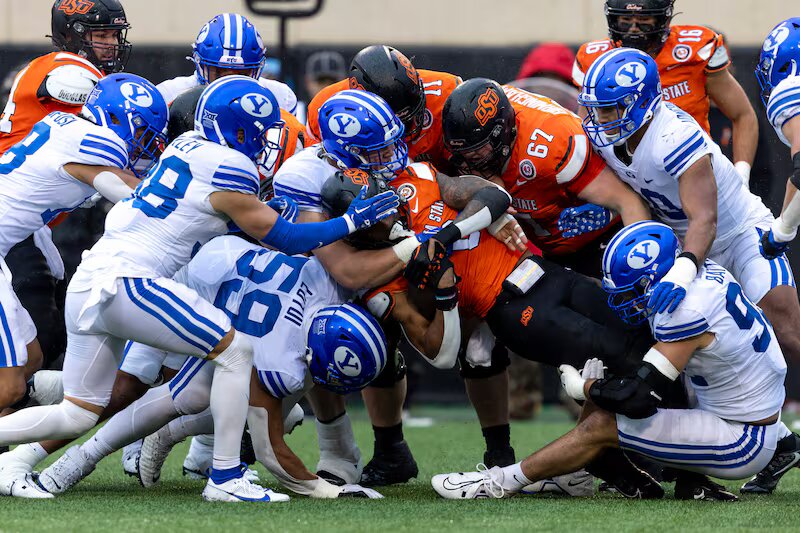
Last season, the Cougars struggled to stop the run. How much will the defense unit improve as they prepare for the 2024 season?

BYU’s defense failed to stop the run last season, so defensive coordinator Jay Hill should be on alert as fall training begins on Wednesday.
BYU’s second-year defensive coordinator and associate head coach brought a slew of benefits to the Cougar defense after leaving his position as head coach at Weber State.
Hill is caught between two worlds: knowing what needs to be done and witnessing its success.
This week, he will receive his 2024 defense unit, and the fundamental goal remains unchanged. It’s not that complicated. It’s not an elaborate design, hope, or dream. It’s quite simple.
Hill wants his defense to halt the run.
He wants to cause mayhem and do all the exciting things that a playmaking defense does during a game. He wants quarterbacks to feel pressure in the pocket, as well as sound and effective coverages. He wants fundamentally solid tackling and his schemes to be executed with ability and insight.
He wants his defense to be a source of turmoil and disturbance.
But none of that counts if opponents can run the ball, gain yards, move the chains, keep the ball away from the offense, and dominate time of possession while his team wears down.
Following spring practice, Hill informed reporters that he expected several of his top players to join the program over the summer.
“The one thing right now with the way recruiting went last year, we feel some of our best players are still going to join us,” Hill told the media.
“It will significantly increase competition. If you do your recruiting correctly, this will always be the case. There will always be new competition. It is the starters’ responsibility to keep their jobs and play well, while the backups must outperform them. We’re looking forward to more competition with those guys coming in.”
A year ago, BYU had one of its most difficult schedules in school history, with ten consecutive P5 opponents. After a 5-2 start, with wins over Arkansas and Texas Tech, the squad never won again.
All four Big 12 entrants had similar growth challenges. BYU, Cincinnati, Houston, and Central Florida have a combined 4-24 record versus Big 12 legacy teams.
Growing pains, yes.
During his first year, Hill witnessed his two expected safeties being hurt early. He lost his leading tackler and captain, Ben Bywater, to a season-ending injury. He lost interior linemen and linebackers, including promising rookie Siale Esera, who suffered a season-ending foot injury. It’s hardly an excuse since everyone gets injured, but his depth wasn’t adequate for Big 12 competition. Many successors were simply not prepared or talented enough to take the call.
As a result, Hill must have watched the remaining four games against Texas, West Virginia, Iowa State, and Oklahoma State with concern. These four teams scored 13 rushing touchdowns, while the rest of their opponents combined for just five.
Texas ran 35 times for 184 yards and two touchdowns. West Virginia in Morgantown ran a whopping 48 times the next week and gained 336 yards with a pair of touchdowns. Iowa State ran 37 times, gained 234 yards and rushed for four touchdowns.
Get the pattern?
Opponents understood exactly what to do to give Hill a headache: run, baby run.
In their final game against Oklahoma State, the Cowboys rushed 41 times for 182 yards and five touchdowns.
No wonder the Cougars finished the season with a five-game losing streak.
With the offense floundering, Hill’s defense faced some exceptional running backs. They delivered blow upon blow, down by down.
BYU ended Hill’s first season in Provo with the 109th-ranked rushing defense. It allowed 2,132 yards on 109 carries for an average of 4.82 yards per attempt, or 177.7 yards per game.
To put things into context, Penn State led the nation in rushing defense, allowing 982 yards on 434 attempts, a 2.26 average per run attempt, 10 touchdowns, and 785.5 yards per game.
It wasn’t as if BYU’s defense was alone in struggling to stop Big 12′s outstanding ball carriers.
Cincinnati ranked 108th, Houston 98th, Oklahoma State 96th, Kansas 88th, Texas Tech 84th, TCU 75th and Kansas State an average rush defense that ranked 54th.
The Big 12 featured five of the top 15 rushers in college football last season, led by OSU’s Ollie Gordon II at No. 2 with a 123.7 yard-per-game average. Texas Tech’s Tahj Brooks ranked No. 4 (118 ypg), RJ Harvey ofTexas Tech at No. 10 (108 ypg), Jonathan Brooks of Texas No. 12 (103 ypg), and at No. 14 was TCU’s Emani Bailey (100.8 ypg).
The Big 12 offensive lines and runners can put numbers on teams.
It will be interesting to see how newcomer Utah, which ranked No. 4 in rushing defense last year as a Pac-12 member, does this season.
In the meantime, Hill knows the deal. I’d project his defense will fare better this season. He has more talent and defense is deeper. His guys more fully understand what is asked of them and he’s prepared them more fully.
This past national letter of intent signing day in February 2024, nine of the 10 highest-ranked recruits signed by BYU were by Hill for defense and included Bountiful safety Faletau Satuala and edge rusher Ephraim Asiata. He also signed Danny Saili, a giant noseguard from Hutchinson Kansas Community College, who was supposed be a big part of the puzzle in fall but Saili transferred to Arkansas after three months in the program.
It’s premature to start listing all the potential stars until after fall practice begins July 31; that is when you get an updated roster and can see who has made it into school, recovered from injuries, and is performing on the field. There’s always a surprise — a new face, or somebody who for whatever reason doesn’t make it on the field.
He must replace three key pieces from a year ago, linebackers Max Tooley and Aj Vongphachanh, and corner Eddie Heckard.
Hill has the challenge of preparing his defense to be physical run stoppers without being injured before the season opener and during the long league season.
It’s a balancing act.
But in the end, you’ve got to be demanding, see results and put players under pressure to make plays while creating competition for roles and create a list to travel.
It will be interesting to see how Hill assembles bodies and coaches up this unit.





